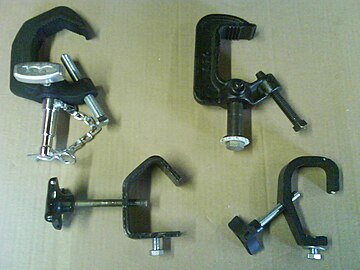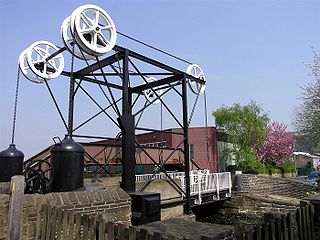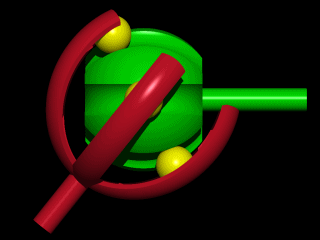This article needs additional citations for verification .(September 2014) (Learn how and when to remove this template message) |

In stagecraft, a c-clamp can refer to a number of different pieces of hardware, depending on its intended use.
This article needs additional citations for verification .(September 2014) (Learn how and when to remove this template message) |

In stagecraft, a c-clamp can refer to a number of different pieces of hardware, depending on its intended use.
In stage lighting and sound a c-clamp, also referred to as a pipe clamp, is used to attach a larger piece of hardware, such as a lighting instrument, a speaker, or a dimmer, to a pipe or batten. Newer c-clamps tend to be constructed of aluminum, although steel is also available.
C-clamps function by affixing a bolt (the "shaft bolt") to the hardware they are to hold in place, such as through the yoke of a lighting instrument, and securely fastening this bolt to the clamp shaft. The open end of the clamp is then placed over the batten, and a bolt (the "clamp bolt") is tightened to secure the c-clamp. C-clamps for stage lighting fixtures usually also have a pan screw (also known as a "grub bolt"), which when loosened will allow the clamp shaft, and therefore the fixture, to be rotated 360 degrees while maintaining a secure connection to the batten.
When using c-clamps care must be taken to not over-torque the clamp bolt which affixes the clamp to the batten. If this bolt is overtightened, it can easily dimple or "drill" into the batten seriously compromising the strength of the batten.



Film and television grips commonly make use of c-clamps that are manufactured specifically for their industry. These clamps are produced with integrated studs designed to accept the mounting hardware from a variety of small, lightweight lighting fixtures, allowing illumination to be placed in unusual or awkward locations quickly and easily.

C-clamps are commonly used in theatrical carpentry for the same purpose that non-theatrical carpenters employ them: for creating a quick, temporary, and non-destructive way of joining two objects together. Legs are commonly attached to platforms via c-clamp before they are fastened together using a more permanent method (i.e. bolts). Multi-platform assemblies are also commonly joined to one another solely with c-clamps, especially in touring situations where a set needs to be assembled and struck quickly.

A coupling is a device used to connect two shafts together at their ends for the purpose of transmitting power. The primary purpose of couplings is to join two pieces of rotating equipment while permitting some degree of misalignment or end movement or both. In a more general context, a coupling can also be a mechanical device that serves to connect the ends of adjacent parts or objects. Couplings do not normally allow disconnection of shafts during operation, however there are torque limiting couplings which can slip or disconnect when some torque limit is exceeded. Selection, installation and maintenance of couplings can lead to reduced maintenance time and maintenance cost.

Stage lighting is the craft of lighting as it applies to the production of theater, dance, opera, and other performance arts. Several different types of stage lighting instruments are used in this discipline. In addition to basic lighting, modern stage lighting can also include special effects, such as lasers and fog machines. People who work on stage lighting are commonly referred to as lighting technicians or lighting designers.

The windlass is an apparatus for moving heavy weights. Typically, a windlass consists of a horizontal cylinder (barrel), which is rotated by the turn of a crank or belt. A winch is affixed to one or both ends, and a cable or rope is wound around the winch, pulling a weight attached to the opposite end. The oldest depiction of a windlass for raising water can be found in the Book of Agriculture published in 1313 by the Chinese official Wang Zhen of the Yuan Dynasty . The Greek scientist Archimedes was the inventor of the windlass.

In the United States, Canada and the United Kingdom, grips are technicians in the filmmaking and video production industries. They constitute their own department on a film set and are directed by a key grip. Grips have two main functions. The first is to work closely with the camera department to provide camera support, especially if the camera is mounted to a dolly, crane, or in an unusual position, such as the top of a ladder. Some grips may specialize in operating camera dollies or camera cranes. The second main function of grips is to work closely with the electrical department to create lighting set-ups necessary for a shot under the direction of the director of photography.
Grips' responsibility is to build and maintain all the equipment that supports cameras. This equipment, which includes tripods, dollies, tracks, jibs, cranes, and static rigs, is constructed of delicate yet heavy duty parts requiring a high level of experience to operate and move. Every scene in a feature film is shot using one or more cameras, each mounted on highly complex, extremely expensive, heavy duty equipment. Grips assemble this equipment according to meticulous specifications and push, pull, mount or hang it from a variety of settings. The equipment can be as basic as a tripod standing on a studio floor, to hazardous operations such as mounting a camera on a 100 ft crane, or hanging it from a helicopter swooping above a mountain range.
Good Grips perform a crucial role in ensuring that the artifice of film is maintained, and that camera moves are as seamless as possible. Grips are usually requested by the DoP or the camera operator. Although the work is physically demanding and the hours are long, the work can be very rewarding. Many Grips work on both commercials and features.

A tap is a valve controlling the release of a liquid or gas.

Constant-velocity joints allow a drive shaft to transmit power through a variable angle, at constant rotational speed, without an appreciable increase in friction or play. They are mainly used in front wheel drive vehicles. Modern rear wheel drive cars with independent rear suspension typically use CV joints at the ends of the rear axle halfshafts and increasingly use them on the drive shaft.

A hose clamp or hose clip or hose lock is a device used to attach and seal a hose onto a fitting such as a barb or nipple.

Ellipsoidal reflector light is the name for a type of stage lighting instrument, named for the ellipsoidal reflector used to collect and direct the light through a barrel that contains a lens or lens train. The optics of an ERS instrument are roughly similar to those of a 35 mm slide projector. There are many types of ERS that are designed for the myriad applications found in the entertainment industry. ERS instruments come in all shapes and sizes. Each particular model of ERS has its own set of characteristics. Generally, ERS instruments are the most varied and utilized type of stage lighting instrument. ERS may also be referred to as Profile Spotlights because the beam can be shaped to the profile of an object. Ellipsoidal reflectors are used for their strong, well-defined light and their versatility. Leko and Source Four are brand names which are often, but inaccurately, used to refer to any sort of ellipsoidal.

A catwalk is an elevated service platform from which many of the technical functions of a theater, such as lighting and sound, may be manipulated.

A vise or vice is a mechanical apparatus used to secure an object to allow work to be performed on it. Vises have two parallel jaws, one fixed and the other movable, threaded in and out by a screw and lever.

A fly system, or theatrical rigging system, is a system of rope lines, blocks (pulleys), counterweights and related devices within a theater that enables a stage crew to fly (hoist) quickly, quietly and safely components such as curtains, lights, scenery, stage effects and, sometimes, people. Systems are typically designed to fly components between clear view of the audience and out of view, into the large opening, known as the fly loft, above the stage.

A C-clamp or G-clamp or G-cramp is a type of clamp device typically used to hold a wood or metal work piece, and often used in, but are not limited to, carpentry and welding. Often believed that these clamps are called "C" clamps because of their C-shaped frame, or also often called C-clamps or G-clamps because including the screw part, they are shaped like an uppercase letter G. However, in fact, they were originally called a carriage maker's clamp, or Carriage Clamp.

Intelligent lighting refers to stage lighting that has automated or mechanical abilities beyond those of traditional, stationary illumination. Although the most advanced intelligent lights can produce extraordinarily complex effects, the intelligence lies with the human lighting designer, control system programmer, or the lighting operator, rather than the fixture itself. For this reason, intelligent lighting is also known as automated lighting, moving lights, moving heads, or simply movers.

Stage lighting instruments are used in stage lighting to illuminate theatrical productions, concerts, and other performances taking place in live performance venues. They are also used to light television studios and sound stages.

A fitting or adapter is used in pipe systems to connect straight sections of pipe or tube, adapt to different sizes or shapes, and for other purposes such as regulating fluid flow. These fittings are used in plumbing to manipulate the conveyance of water, gas, or liquid waste in domestic or commercial environments, within a system of pipes or tubes.

In theaters, a batten is a long metal pipe suspended above the stage or audience from which lighting fixtures, theatrical scenery, and theater drapes and stage curtains may be hung. Battens that are located above a stage can usually be lowered to the stage or raised into a fly tower above the stage by a fly system.

The shaft collar is a simple, yet important, machine component found in many power transmission applications, most notably motors and gearboxes. The collars are used as mechanical stops, locating components, and bearing faces. The simple design lends itself to easy installation.

A Riser clamp is a type of hardware used by mechanical building trades for pipe support in vertical runs of piping (risers) at each floor level. The devices are placed around the pipe and integral fasteners are then tightened to clamp them onto the pipe. The friction between the pipe and riser clamp transfers the weight of the pipe through the riser clamp to the building structure. Risers are generally located at floor penetrations, particularly for continuous floor slabs such as concrete. They may also be located at some other interval as dictated by local building codes or at intermediate intervals to support plumbing which has been altered or repaired. Heavier piping types such as cast iron require more frequent support. Ordinarily, riser clamps are made of carbon steel and individually sized to fit certain pipe sizes. "Riser" refers to vertical runs of pipes, electrical conduit and tubes.
Stage lighting accessories are components manufactured for conventional (non-automated) stage lighting instruments. Most conventional fixtures are designed to accept a number of different accessories designed to assist in the modification of the output. These accessories are intended to either provide relatively common functionality not originally provided in a fixture, or to extend the versatility of a lighting instrument by introducing features. Other accessories have been designed to overcome limitations or difficulties some fixtures present in specific applications.